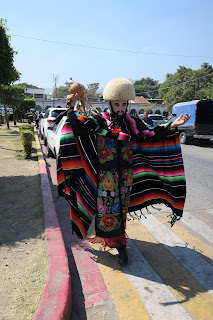Chiapa de Corzo is a small city and municipality situated in the west-central
part of the Mexican state of Chiapas. Located in the Grijalva River valley of
the Chiapas highlands, Chiapa de Corzo lies some 15 km (9.3 mi) to the east of
the state capital, Tuxtla Gutiérrez.
Chiapa has been occupied since at least 1400 BCE, with a major archeological
site which reached its height between 700 BCE and 200 CE. It is important
because the earliest inscribed date, the earliest form of hieroglyphic writing
and the earliest Mesoamerican tomb burial have all been found here.
Chiapa is also the site of the first Spanish city founded in Chiapas in 1528.
The "de Corzo" was added to honor Liberal politician Angel Albino Corzo.
|
La Pila fountain.
The La Pila fountain is a fountain located in the square of Chiapa de
Corzo, Chiapas.
-
It was constructed in 1562 in Moorish style, made of brick in the form
of a diamond.
-
It measures fifty two meters in circumference and twelve meters in
height.
-
It has eight arches and a cylindrical tower which occasionally
functioned as a watchtower.
|
|
A Parachico dancer.
The Great January Feast (Fiesta Grande de Enero) takes place from
4 to 23 January every year in Chiapa de Corzo, to honor local patron
saints Our Lord of Esquipulas, Anthony the Great and Saint Sebastian.
-
The festival has been included in UNESCO's Intangible Cultural
Heritage Lists on November 16, 2010, listed as "Parachicos in the
traditional January feast of Chiapa de Corzo".
-
Since then, the event has experienced a surge in interest, making the
Dance of the Parachicos the highlight.
|
|
The Parachicos dress.
The Parachicos dress in a mask, a helmet or wig made of ixtle, a
Saltillo style sarape. The mask is carved of wood and decorated with
lacquer to mimic a Spanish face.
-
Originally the masks had beards, but over time they evolved and many
have an almost childlike look.
- The ixtle head covering is supposed to mimic blonde hair.
-
The dancers carry a type of maraca made of metal called chinchin to
make noise along with the taping of their boot heels.
|
|
A woman from Chiapas.
At the end of the parade is the patron who is accompanying by a
“Chulita” a young woman who does not wear a mask, but rather an old
fashioned traditional Chiapan dress, with a long skirt, embroidered
shirt and roses.
- She represents the women of Chiapas.
|
El Campanario Restaurant
|
Entering the El Campanario Restaurant.
Offering typical Chiapas food, the place will offer you an atmosphere
that is also typical of the town.
-
So while you enjoy some Chiapas enchiladas, cochito or chamorro,
accompanied by chia water or a pozol, you will have the marimba
enlivening your meal so that you leave with the complete experience.
|
|
Walking into the dining room.
A well-decorated restaurant in the center of town, el Campanario offers
typical fare for Chiapa de Corzo and Chiapas.
|
|
Appetizer.
Tortilla stuffed with fresh cheese.
|
|
Main course.
Fried river fish accompanied with tomato rice, cucumber, tomato and
grated carrot.
|
See also
Sources
Location











